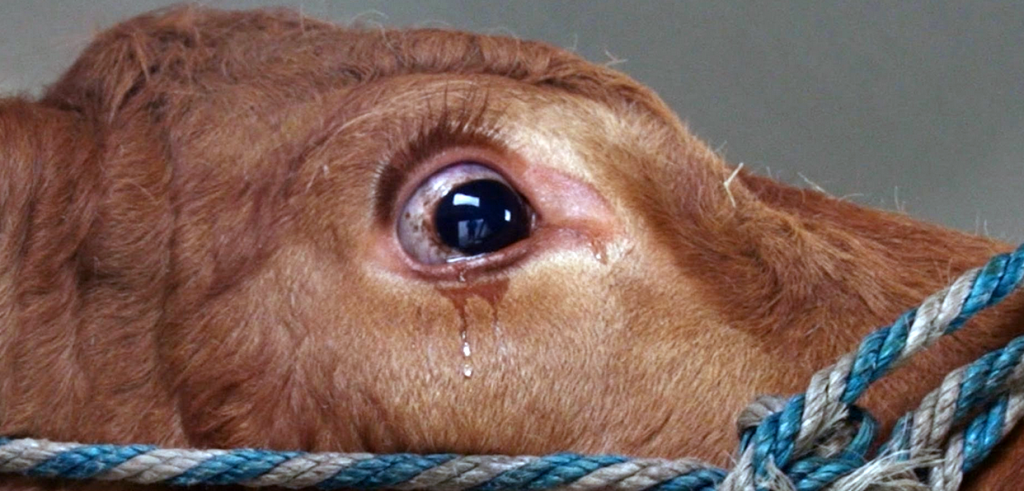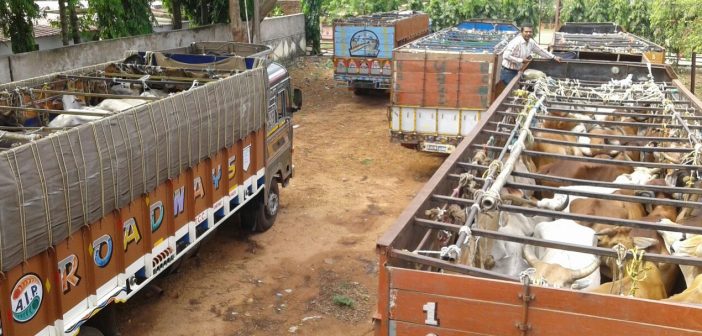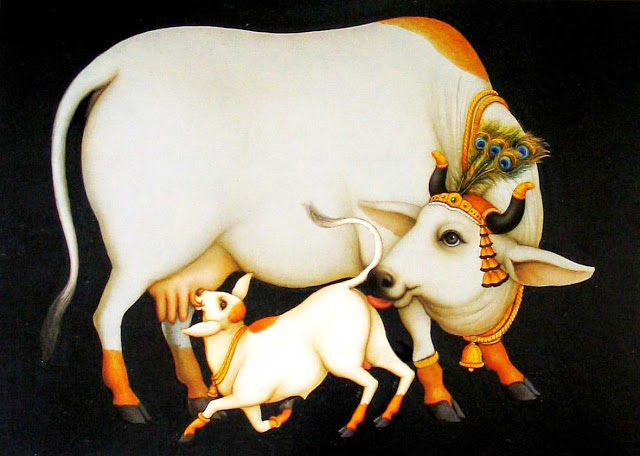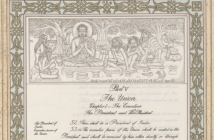Unbeknownst to many and in contradiction to the cow-loving brand that has been propagated, India is a dominant force in the global beef and leather markets. For a sizeable list of reasons, India has been propelled into as a global leader of not only animal bovine products but some of the worst violations in bovine rights. The statistics in the infographic highlight the depth of the dynamics of its beef and leather industries. This is despite the fact that unlike in industrialized countries, India does not a have a formal beef industry i.e. cattle is not reared specifically for slaughter. In fact, except Kerala and West Bengal, cow slaughter is banned in most states. Only bulls and buffaloes that have received ‘fit-for-slaughter’ certificate can be culled for meat.
 There is another market prevalent in many parts of India, that of ‘pseudo-mutton’ – meat from young calves. This meat is most highly valued by consumers and hence for farmers this is the most cash-rewarding. This is mostly the meat available in roadside bars and restaurants (often sold in the name of goat or sheep mutton).
There is another market prevalent in many parts of India, that of ‘pseudo-mutton’ – meat from young calves. This meat is most highly valued by consumers and hence for farmers this is the most cash-rewarding. This is mostly the meat available in roadside bars and restaurants (often sold in the name of goat or sheep mutton).
A Reality Check
India also stands among the lowest in the pecking order of ethical treatment of slaughter animals. The brutalities inflicted and the scale is no less than a genocide. According to conservative estimates by PETA, roughly two million cattle are annually transported to the state of West Bengal from where they are smuggled to slaughterhouses in Bangladesh. In violation of transportation laws such as Transport of Animals Rules, 1978 and Motor Vehicles Act, 1988 (which allow for 4 to 6 animals to be transported at a time) almost 25-30 are crammed in a lorry. They are beaten, kicked, deprived of food and water, and are often trampled to death due to high speed driving of the lorries. Pack and draft animals with their large torsos and relatively weak legs are ill-equipped for the bumpy rides on Indian roads. Their limbs get broken during transport because cattle smugglers often drive through rural roads to avoid police check-posts. They are tied together with ropes piercing through their noses. When their pace slows down, their tails are snapped, or tobacco, chilly powder and salt are rubbed into their eyes. The unlucky animals that reach the abattoirs alive, are killed by slitting their throats. Others are skinned alive.
Even in licensed slaughterhouses, cattle are routinely beaten and electrocuted.[1] Since by law healthy young cattle cannot be killed, their owners maim them, break their legs or poison them so that they can be declared ‘fit-for-slaughter’ by corrupt veterinary doctors or serving state officials.[2] Maneka Gandhi once noted that she saw 900 cows crammed in a train wagon that had a capacity of 80-100. On arrival, 400-500 came out dead.[3] In Kerala, they have a unique way of killing cattle – their heads are beaten to a pulp by a dozen hammer blows.
Writes Anne Kellogg in the Quartz[4]:
Science—and common sense—tells us that cows are sentient beings who value their lives in the same ways that we value ours. Did you know that cows[5] have distinct personalities? Some are bold and adventurous, while others are shy and timid. They are intelligent and curious animals who form social hierarchies, can recognize more than 100 members of their herd, have best friends and cliques, and even hold grudges against other cows who have treated them badly. They also mourn when a loved one dies, and there are countless reports of mother cows frantically calling and searching for their calves after they have been taken away and sold for veal.

While we continue to believe in ourselves as world leaders in vegetarianism, it is easy to make up from the numbers of cattle slaughtered that this is not possible only due to food habits of Muslims and Christians in India. The irony is that while Hindus largely do not consume beef or buffalo meat, the supply of bovines comes from farmers that are predominantly Hindu. What explains this strange dual behavior – of least consumption and highest production? Critical scholars will very likely quote-patchy texts from Hindu scriptures to propose that we were always a beef-consuming race. That with the discovery of the bulls’ utility for farming we changed preferences. Very convenient, but this does not explain why no other civilization – which have all done equally well in discovering agriculture – did not follow the same path. Ill-informed and sentimental dharma-rakshaks on the other hand, will be in constant denial that there is anything wrong with our ‘cow protection’ culture. They will not want to even see that the milch cows from our dairy industry is actually the main source of beef cattle apart from bulls and buffaloes.
The Social and Legal loopholes in Cow Slaughter
There are two aspects to why we have a buoyant cattle slaughter industry – the physical and the psychological. Firstly, there is this bad economics for a stressed farmer in maintaining cattle that can neither work in the fields nor give milk (technically known as ‘useless’ cattle). This is especially a problem in drought prone areas where green fodder is not readily available and buying dry fodder makes maintenance quite expensive. In desperate conditions where a farmer prefers to commit suicide so that their family can partake of some meagre government compensation, it is not hard to think they will sell their cattle even if there is an emotional bond. In fact, decades of penury and struggle for basic existence have desensitized farmers to an extent that selling cattle for slaughter is a norm and has become an important part of their income smoothing behavior. Hence farmers have been badly hit by the new anti-slaughter laws in Maharashtra, for instance, where prices of cows in the secondary (slaughter) market has fallen by over 50% owing to a reduction in their demand.[6] Over the last few decades, the useful cattle life has now come to average around 4-5 years. Farmers knowing this, pump them with hormones and perform other unethical practices, so as to maximize milk extraction during this productive lifetime. Once the cattle is weak and useless, they fetch a price in the secondary market that is either the same or higher than what they spent on buying it. So for them selling cattle is ‘good’ economics.
A second feature is loose regulation and enforcement of ethical treatment principles. To give an idea, the Food and Agricultural Organization of the United Nations (FAO) assess the best practices of welfare for slaughter animals in the European Union. Just to sample a few of the hundreds of micro regulations:
- ill or injured animals should be segregated and offered comfortable bedding;
- air circulation, dust levels, temperature and gas concentrations should be such that animals are not harmed;
- animals must be provided artificial lighting when natural lighting is not available;
- all automatic and mechanical equipment important for upkeep of good animal health must be inspected every day;
- animals must be provided appropriate feed and water so that all their physiological needs are satisfied;
- only certified and competent drivers are allowed to transport animals;
- a journey log has to be maintained by drivers with details of journey times, food, rest and water;
- slaughter operations can be carried out only by certified butchers;
- all animals need to be compulsorily stunned before slaughter (stunning is an intentionally induced process which causes loss of consciousness and sensibility);
- carotid arteries and blood vessels must be severed immediately so that there is maximum blood loss leading to death before the effects of stunning fade away and the animal regains consciousness;
- the only exception to stunning is for religious slaughter where animals are killed in full consciousness.
In India, even the legal framework is very weak, not to mention the enforcement. While statutes enjoin dos and don’ts, they don’t stipulate penal provisions for contravention. Consequently, there is limited deterrence. The basic institution here is The Prevention of Cruelty to Animals Act, 1960 with an amendment in 1982.[7] In this Act, the only mention of slaughter animals is under Section 9.e. and in relation to the role of the Animal Welfare Board of India (AWBI) which is to:
advise the Government or any local authority or other person in the design of slaughter-houses or the maintenance of slaughter houses or in connection with slaughter of animals so that unnecessary pain or suffering, whether physical or mental, is eliminated in the pre-slaughter stages as far as possible, and animals are killed; wherever necessary, in as humane a manner as possible;
Due to its obvious lack of specificity, in 2001 the Central Government instituted rules specific to slaughter houses known as the Prevention of Cruelty to Animals (Slaughter House) Rules, 2001.[8] This was a great advance as far as formal rules for legal slaughter houses were concerned. In it are enshrined a few ethical treatment guidelines, such as: no animal can be slaughtered in the sight of other animals; mandatory stunning before slaughter; compulsory veterinary inspection before culling and protection of animals from heat, cold and rain. Yet, they are not sufficient and no way close to international standards. Most of the regulations within this Act are concerned with infrastructural specifications that need to be adhered to by any slaughter house for receiving a license. Failing compliance such abattoirs can be shut down. Yet, empirical observation suggests gross non-compliance by licensed slaughter houses. And given that the number of illegal slaughterhouses is roughly ten times that of the legal ones, the scale of brutality can only be imagined.
The Ethical Quotient in Slaughter
From the sense of government, the economic and the regulatory reasons are necessary conditions for a buoyant illegal slaughter industry, but they are not sufficient. In the ethical sense while there can be no justification or better way to legislate the business of brutality, the third and the psychological component is inevitable, which I call as displaying the NIMBY syndrome: Not in My Backyard. As long as I don’t have to witness the pain of my cattle, I will sell them; as long as my house doesn’t get stained by blood, let slaughterhouses exist; as long as I don’t have to butcher myself, let’s eat dead animals; as long as my country/state does not permit, let cattle be trafficked and genocide happen; as long as I can buy cheap milk, let the giver of the milk walk towards brutal death.
NIMBY is an attitude ascribed to persons who object to the siting of something they regard as detrimental or hazardous in their own neighborhood, while by implication raising no such objections to similar developments elsewhere.
(Oxford English Dictionary, 2005)
Essentially the mentality is – Adharma can exist, but Not in My Backyard!
So what is the way forward? Is it a hopeless situation given the sheer magnitude of the problem and sensitive personal food preferences? Or barring of all animal derived products (including milk) is the ultimate way out? As must be clear by now, it is a multi-pronged problem – so the solutions have to be at economic, legal and moral levels. The first step is to ensure rural livelihoods are strengthened, where the dairy value chain ensures cattle can be supported very economically even after it is past its utility. Research into products and utilities based on cow-dung and cow-urine would further strengthen the morale behind cow protection. A mechanism to compensate farmers for upkeep – such as micro-finance or community supported gaushalas, panjarpoles can help. It is high time temples make sure a certain portion of its income is mandated for setting-up and running of gaushalas. It is also important to preserve commons or designated cattle grasslands (gomala lands) in villages. Many such initiatives exist already, but they need to be scaled up.

A shift to complete milk-less diet as propounded by vegan organizations will be a stretch as there is no counterfactual to prove that a meat industry will also evaporate along with it. It is akin to throwing the baby out with the bath water. Milk is not a problem, neither are cows, as long as the dairy process is ethical and loving. One way is to incorporate a cleaner milk market through higher prices. Of course, expenditure saved on meat can help match up the price mark-up for the urban consumer, while a targeted price rationing can be devised for low income households to maintain their nutritional balance. Difficult but not impossible.
Those in the business of brutality should be punished severely as per the law of the land, whether they are cattle thieves or illegal slaughter house owners. Rules of ethical treatment have to be enforced with strictness and those not adhering to those should face stringent sanctions. It’s high time the Draft Animal Welfare Act, 2011 which contain more sensitive guidelines for ethical treatment, be passed by the Parliament. Most importantly though, a dharma-based education and awareness needs to spread aggressively by all humanitarian organizations, so as to counter the Not in My Backyard attitude.
One common justification for beef-eating provided by scholars, especially in the context of India, is that ancient and pre-medieval Indians ate beef. Even if that were true, so what? Should we also promote slavery because one of the world’s ‘greatest’ nations believed in that for centuries? Let’s focus on the present day: the enemy here is extraordinary brutality, the fight is about simple, ordinary morality. Dharma teaches us that the universe is our home and each one our family – Vasudhaiva kutumbakam – what then is Not in My Backyard?
[2] http://www.frontline.in/static/html/fl1818/18180380.htm
[3] http://www.independent.co.uk/news/world/asia/how-indias-sacred-cows-are-beaten-abused-and-poisoned-to-make-leather-for-high-street-shops-724696.html
[4] https://qz.com/578941/bangladeshs-nightmarish-leather-industry-makes-the-case-for-vegan-products/
[5] http://www.peta.org/issues/animals-used-for-food/factory-farming/cows/hidden-lives-cows/
[6] http://indianexpress.com/article/india/india-news-india/dairy-economics-a-ban-most-farmer-unfriendly/





